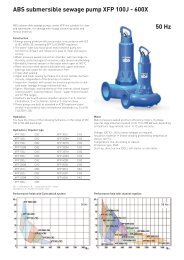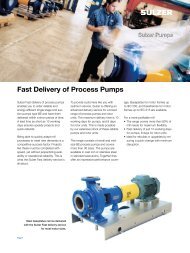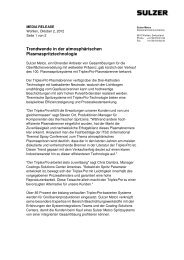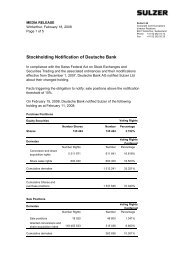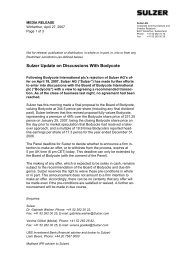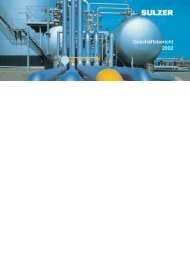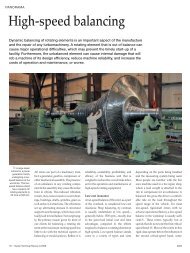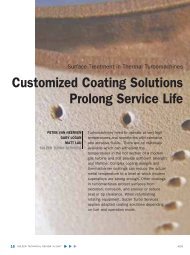Cost-efficient production of ethanolamines
Cost-efficient production of ethanolamines
Cost-efficient production of ethanolamines
You also want an ePaper? Increase the reach of your titles
YUMPU automatically turns print PDFs into web optimized ePapers that Google loves.
12<br />
PETER FÄSSLER<br />
SULZER CHEMTECH<br />
AUREO CELEGHIN<br />
CELEGHIN<br />
A new approach to an established product<br />
<strong>Cost</strong>-<strong>efficient</strong> <strong>production</strong><br />
<strong>of</strong> <strong>ethanolamines</strong><br />
Sulzer Chemtech has over 30 years <strong>of</strong> experience in<br />
the field <strong>of</strong> ethanolamine technology. Its expertise<br />
includes the provision <strong>of</strong> comprehensive engineering<br />
services for the modernization <strong>of</strong> existing plants,<br />
as well as the manufacturing <strong>of</strong> key components for<br />
plants such as distillation column internals (Fig. 1).<br />
Sulzer Chemtech and Celeghin Consultants<br />
Corporation <strong>of</strong> Houston, TX, USA, teamed up to<br />
create an innovative new ethanolamine technology<br />
solution that optimizes product quality and<br />
process flexibility while lowering energy consumption<br />
during <strong>production</strong>. This complete<br />
solution reduces the investment and operating<br />
costs related to the <strong>production</strong> <strong>of</strong> <strong>ethanolamines</strong>.<br />
SULZER TECHNICAL REVIEW 3/2008 4243
Ethanolamines are flammable,<br />
corrosive, colorless, viscous<br />
liquids that are produced by<br />
the reaction between ammonia<br />
(NH3) and ethylene oxide (EO).<br />
Identified many years ago,<br />
<strong>ethanolamines</strong> are a key ingredient<br />
in a number <strong>of</strong> important<br />
product formulations such as<br />
cosmetics and personal hygiene<br />
applications, agricultural products,<br />
wood-preservation chemicals,<br />
soaps and detergents, gas<br />
treatments. They can also be used<br />
in the <strong>production</strong> <strong>of</strong> non-ionic detergents,<br />
emulsifiers, and soaps,<br />
as well as in emulsion paints, polishes,<br />
and cleansers.<br />
Flexible ethanolamine<br />
<strong>production</strong> technology<br />
There are 3 types <strong>of</strong> <strong>ethanolamines</strong>:<br />
mono<strong>ethanolamines</strong> (MEA), di<strong>ethanolamines</strong><br />
(DEA), and tri<strong>ethanolamines</strong><br />
(TEA). The formation<br />
<strong>of</strong> MEA, DEA, or TEA<br />
depends on whether an ammonia<br />
molecule reacts with 1, 2, or 3<br />
ethylene oxide molecules (Fig. 2).<br />
Unlike conventional ethanolamine<br />
<strong>production</strong> technology, which is<br />
<strong>of</strong>ten limited in terms <strong>of</strong> the ratio<br />
<strong>of</strong> ammonia to ethanolamine that<br />
can be handled, the flexible Sulzer<br />
Chemtech solution <strong>of</strong>fers the option<br />
<strong>of</strong> altering the amounts <strong>of</strong> the<br />
final product generated. The composition<br />
<strong>of</strong> the resulting mixture is<br />
determined by the ratio between<br />
the raw materials, which can be<br />
varied in accordance with requirements.<br />
The higher the proportion<br />
<strong>of</strong> ammonia, the more monoethanolamine<br />
is formed (Fig. 3).<br />
The Sulzer Chemtech process can<br />
handle ammonia to ethanolamine<br />
ratios up to or exceeding 6:1 and<br />
<strong>of</strong>fers the customer a high level <strong>of</strong><br />
MEA or DEA distribution while<br />
minimizing the volume <strong>of</strong> TEA<br />
produced (Fig. 4).<br />
Lower costs<br />
The volume <strong>of</strong> water used in<br />
ethanolamine <strong>production</strong> can<br />
vary: if the water content remains<br />
low during the process, it is necessary<br />
for the reaction to be conducted<br />
under high pressure—resulting<br />
in high investment costs. These reactions<br />
consume a low level <strong>of</strong> energy.<br />
In order to lower investment<br />
costs, a high water content may be<br />
used under low pressure, but the<br />
related energy consumption will<br />
consequently be higher. The new<br />
ethanolamine technology solution<br />
<strong>of</strong>fered by Sulzer Chemtech combines<br />
the advantages <strong>of</strong> the highpressure<br />
ammonia route with the<br />
benefits <strong>of</strong> the low-pressure<br />
process. The process allows the<br />
use <strong>of</strong> a relatively low-pressure<br />
reaction and incorporates very<br />
advanced heat integration, which<br />
saves costs across the board.<br />
The Sulzer Chemtech water recovery<br />
system, which uses the energy<br />
integration concept, thermally ties<br />
the water evaporator to the ammonia<br />
stripper column and minimizes<br />
the size <strong>of</strong> the drying column.<br />
It thus enables the plant to<br />
operate economically even at ammonia<br />
to ethylene oxide ratios <strong>of</strong><br />
6:1 or above. Furthermore, the<br />
presence <strong>of</strong> water as a catalyst in<br />
the synthesis <strong>of</strong> ethanolamine ensures<br />
a rational and economical reactor<br />
setup. The use <strong>of</strong> water provides<br />
the greatest control over the<br />
temperature rise in the reactor system<br />
and allows a reduction in the<br />
volume <strong>of</strong> the reactor. The average<br />
reaction temperature can be lowered<br />
and adjusted to minimize secondary<br />
side reactions that could<br />
compromise the quality <strong>of</strong> the<br />
resulting ethanolamine.<br />
Ammonia recovery<br />
The key to saving energy in the<br />
<strong>production</strong> <strong>of</strong> ethanolamine lies in<br />
the design and operating pressure<br />
<strong>of</strong> the main ammonia absorber.<br />
The ammonia stripper is integrated<br />
directly with the absorber by<br />
feeding the stripper overhead vapors<br />
into the bottom <strong>of</strong> the ammonia<br />
stripper. In other words, there<br />
is a direct connection between the<br />
two columns. In addition, the<br />
overhead vapors from the main<br />
water distillation columns are<br />
used as a heat source for the ammonia<br />
stripper reboiler.<br />
The pressure at the top <strong>of</strong> the main<br />
1 Jilin ethanolamine<br />
<strong>production</strong> plant<br />
in China.<br />
SULZER TECHNICAL REVIEW 3/2008 13
2 Mono-, di-, and<br />
tri<strong>ethanolamines</strong> are<br />
produced by reacting<br />
ethylene oxide<br />
with ammonia.<br />
%<br />
Amine %<br />
14<br />
60<br />
10<br />
3 NH3/EO ratio<br />
6<br />
80<br />
NH3<br />
SULZER TECHNICAL REVIEW 3/2008<br />
MEA<br />
DEA<br />
TEA<br />
MEA<br />
DEA<br />
TEA<br />
20<br />
1 MEA/EO ratio<br />
5<br />
HO<br />
HO<br />
H2N<br />
NH<br />
N<br />
OH<br />
OH<br />
OH<br />
OH<br />
3 The ratio <strong>of</strong> MEA, DEA, and TEA produced can<br />
be varied by altering the ratio <strong>of</strong> the reactants.<br />
Ethanolamine (EA) product distribution (reaction 1)<br />
4 The second reaction is required<br />
to produce a higher level <strong>of</strong> DEA.<br />
Ethanolamine (EA) product distribution (reaction 2)<br />
water evaporation column is limited<br />
by the maximum permissible<br />
temperature at the bottom <strong>of</strong> the<br />
column. Hence, the boundary operating<br />
conditions <strong>of</strong> the ammonia<br />
absorber, ammonia stripper, and<br />
main water evaporation column<br />
are basically fixed. The only degree<br />
<strong>of</strong> flexibility in the design is<br />
in the selection <strong>of</strong> the column operating<br />
conditions, column internals,<br />
and the heat exchanger.<br />
Sulzer Chemtech has added thermal<br />
and energy integration to the<br />
ammonia absorber, the ammonia<br />
stripper, and the water distillation<br />
column. As a direct consequence<br />
<strong>of</strong> this thermal and process heat integration,<br />
the energy required by<br />
the improved process is comparable<br />
to the high-pressure route<br />
(Fig. 5).<br />
The increase in the ammonia concentration<br />
in the ammonia absorber<br />
is a direct result <strong>of</strong> the<br />
process heat integration and has a<br />
significant impact on overall energy<br />
consumption. The higher the<br />
operating pressure in the ammonia<br />
absorber, the higher the ammonia<br />
concentration. The higher the<br />
ammonia content, the less water<br />
has to be handled in the system.<br />
Since the water must be recycled<br />
back into the system by means <strong>of</strong><br />
evaporation, each percentage<br />
point increase in the ammonia concentration<br />
leads to an approximate<br />
energy saving <strong>of</strong> between 1.5 and<br />
2%—which represents a significant<br />
reduction in absolute terms.<br />
The ammonia concentration can<br />
also be set to allow for the <strong>efficient</strong><br />
and economical recovery <strong>of</strong> the<br />
residual ammonia from the reaction<br />
loop. This recovery occurs at<br />
a pressure that is sufficiently low<br />
to ensure that the ammonia stripping<br />
takes place at a low tempera-<br />
ture, thus reducing the possible<br />
degradation <strong>of</strong> the product and<br />
minimizing the corrosion <strong>of</strong> equipment.<br />
The high ammonia concentration<br />
allowed by the Sulzer Chemtech<br />
process further reduces the size <strong>of</strong><br />
the ammonia stripper and ammonia<br />
scrubber and eliminates the<br />
need for an additional auxiliary reboiler<br />
heated by an external heating<br />
source. These features significantly<br />
reduce investment costs.<br />
A clear advantage<br />
Ethanolamines are sensitive to<br />
heat and therefore tend to degrade<br />
and must be separated with great<br />
care. The higher the temperature<br />
(respectively the pressure), the<br />
more colored the <strong>ethanolamines</strong><br />
become. Color is, however, the<br />
most important characteristic determining<br />
their quality and value;<br />
the more colorless the substances<br />
are, the higher their market value.<br />
The use <strong>of</strong> high-efficiency packings<br />
from Sulzer Chemtech and<br />
the rational design <strong>of</strong> the distillation<br />
train minimizes the packing<br />
volume and enables the column to<br />
be operated at a lower temperature,<br />
with narrow residence time<br />
distribution and minimum permanent<br />
holdup. The separation <strong>of</strong><br />
<strong>ethanolamines</strong> at these carefully<br />
maintained conditions improves<br />
the product color and reduces<br />
the corrosion at the bottom <strong>of</strong> the<br />
column.<br />
Accelerated <strong>production</strong> without<br />
ethanolamine recycling<br />
The <strong>ethanolamines</strong> produced are<br />
<strong>of</strong>ten recycled back into the main<br />
reactor system in order to adjust<br />
the desired MEA:DEA:TEA ratio.<br />
If the reaction is performed in the<br />
primary reactor, the recycling not
only consumes more energy and<br />
requires a higher residence time<br />
but can also lower the product<br />
quality through the development<br />
<strong>of</strong> color and an increase in corrosion.<br />
The Sulzer Chemtech concept<br />
avoids the difficulties associated<br />
with recycling and eliminates repeated<br />
process steps, thus reducing<br />
the overall residence time in<br />
the plant and lowering energy<br />
consumption.<br />
Avoiding product stress<br />
Product stress is defined as the<br />
tendency <strong>of</strong> the product to degrade<br />
and carbonize at the bottom<br />
<strong>of</strong> the column. Product stress can<br />
be minimized through the rational<br />
study <strong>of</strong> the temperature pr<strong>of</strong>ile<br />
and the configuration at the bottom<br />
<strong>of</strong> the column, resulting in less<br />
product degradation. Side reactions,<br />
such as color precursors, can<br />
be suppressed to a certain extent<br />
through the smooth execution <strong>of</strong><br />
the process at the lowest temperatures<br />
possible.<br />
The level <strong>of</strong> product stress is directly<br />
related to the hot product<br />
residence time and is exponentially<br />
related to the temperature <strong>of</strong> the<br />
hot product (see box). The Sulzer<br />
Chemtech process for ethanol-<br />
Product stress<br />
~ A×(residence time) T<br />
where:<br />
Residence time = the time in<br />
minutes during which the<br />
average bottom product<br />
molecule stays in the bottom<br />
<strong>of</strong> the column.<br />
T = the absolute temperature<br />
<strong>of</strong> the hot stream at the<br />
bottom <strong>of</strong> the column.<br />
A = a proportionality factor.<br />
Demi-water<br />
NH3<br />
EO<br />
Ammonia<br />
absorption<br />
Reaction 1<br />
Ammonia<br />
stripping<br />
amine <strong>production</strong> makes effective<br />
use <strong>of</strong> the product stress concept<br />
to ensure the best handling <strong>of</strong> the<br />
hot product at the bottom <strong>of</strong> the<br />
column.<br />
Purification<br />
The synthesis and purification <strong>of</strong><br />
<strong>ethanolamines</strong> is a relatively complex<br />
process as the final product<br />
quality is determined by the presence<br />
<strong>of</strong> minor impurity streams<br />
in the feed, as well as by internal<br />
recycle streams, thermal process<br />
integration, and the reaction <strong>of</strong><br />
individual components including<br />
side reactions.<br />
Integrated approach<br />
A fully integrated approach<br />
throughout the plant is a prerequisite<br />
for a successful design. Sulzer<br />
Chemtech and Celeghin have<br />
therefore adopted a single block<br />
for the entire process simulation.<br />
This module has been systematically<br />
improved not only by integrating<br />
the accumulated knowhow<br />
but also by relying on real<br />
plant operating data and performance<br />
characteristics. This type <strong>of</strong><br />
comprehensive simulation tool is<br />
sophisticated enough to provide a<br />
satisfactory description <strong>of</strong> plant<br />
details and serves as a powerful<br />
tool for the analysis <strong>of</strong> possible<br />
process improvements, for heat<br />
integration, and for new plant<br />
Ethanolamine technology: overview<br />
Concentration<br />
EO<br />
Distillation<br />
Reaction 2<br />
Water purge<br />
MEA<br />
DEA<br />
TEA<br />
Residue/TEA<br />
designs. Any adjustments that are<br />
required, e.g. relating to product<br />
capacity and product distribution,<br />
can be implemented relatively<br />
quickly and with a high degree <strong>of</strong><br />
reliability.<br />
In addition, the accumulation <strong>of</strong><br />
unwanted byproducts or feed impurity<br />
products trapped in the<br />
process loops can be detected and<br />
eliminated through purging at<br />
specific locations.<br />
Since such complex design approaches<br />
are very time consuming,<br />
they are only justified for selected<br />
process steps in ethanolamine <strong>production</strong>—an<br />
area in which Sulzer<br />
Chemtech has extensive experience,<br />
supported by a diversified<br />
range <strong>of</strong> market applications.<br />
Contact<br />
Sulzer Chemtech AG<br />
Peter Fässler<br />
Sulzer-Allee 48<br />
8404 Winterthur<br />
Switzerland<br />
Phone +41 52 262 37 29<br />
Fax +41 52 262 00 64<br />
peter.faessler@sulzer.com<br />
5 Sulzer Chemtech<br />
provides a complete<br />
and flexible solution<br />
for ethanolamine<br />
<strong>production</strong>.<br />
SULZER TECHNICAL REVIEW 3/2008 15



